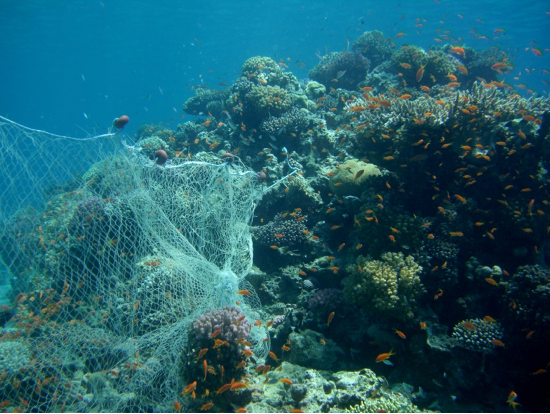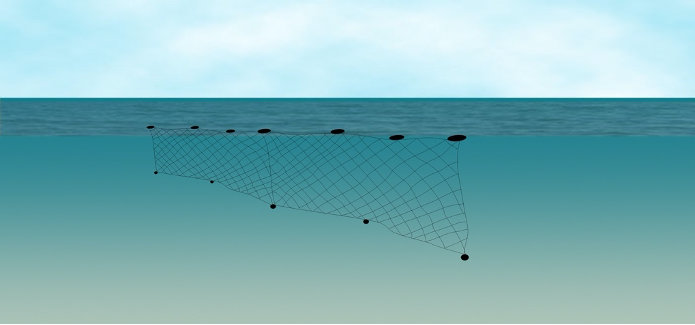Reference: Grimaldo, E., Herrmann, B., Jacques, N., Kubowicz, S., Cerbule, K., Su, B., Laren, R., & J. Vollstad. 2020. “The effect of long-term use on the catch efficiency of biodegradable gillnets.” Marine Pollution Bulletin 161 e111823.
Doi: doi.org/10.1016/j.marpolbul.2020.111823.
Ghost fishing-as spooky as it sounds
“Ghost fishing” refers to how old or discarded nets can still ensnare fish or other marine life while floating in the water after they’ve been lost or abandoned. In the fishing industry, gillnets are a common and inexpensive way to catch fish. These long nets hang down in the water, catching fish by the gills as they try and swim through the net. Gillnets are effective and cheap, but problems can occur if the nets are lost or abandoned in the ocean. Old nets can trap sea turtles, dolphins, seals, birds, animals that weren’t the original fishing target. This can cause injuries, prevent animals from being able to move freely, and even stop mammals from getting to the surface for air. It’s estimated there are about 640,000 tons of ghost nets currently in the ocean.
These nets are made of synthetic (man-made) plastic fibers like nylon, which are resistant to breaking down so the nets will stay in the water for a long time. When the nylon fibers do break down, they can create smaller microplastics that further pollute the ocean.
So how to solve this problem? Some researchers and citizen scientists are putting effort into tracking lost nets and re-collecting them. The National Oceanic and Atmospheric Administration’s Marine Debris program is working with fishermen to reduce the amount of “ghost nets” in coastal waterways, for example. Another option, however, is to transition to nets made of biodegradable (natural) fibers, instead of synthetic fibers. These biodegradable nets completely degrade and therefore don’t “ghost fish” for very long, and they don’t create microplastics. But are these nets as efficient as the conventional nylon nets?

The experiment:
Researchers from Norway set out to test this exact question. They deployed 16 biodegradable and 16 nylon gillnets over the course of 3 Atlantic cod fishing seasons, with each season lasting approximately 3 months, for a total of about 1000 hours in the water. In between seasons the nets were held in storage. The biodegradable nets were made of a resin called PBSAT- a type of natural resin blended with a biodegradable polymer. The researchers compared how many fish were caught in biodegradable and nylon nets, and how large those fish were. This information was used to determine what’s called the relative catch efficiency– or how efficient each type of net is relative to the size of the fish being caught.
Researchers also conducted a separate experiment, simulating the conditions the nets would see in the ocean to determine how the strength and chemical properties changed over time, and how the nets broke down or degraded.

The reveal:
Unsurprisingly, the biodegradable nets broke down significantly during the aging test compared to the nylon nets. Given that this is the point of biodegradable fibers, that result was expected. However, the biodegradable nets were also less efficient at catching cod than the nylon nets, on average catching 18.35%, 40.20%, and 47.36% fewer fish in each season than the conventional nets. The difference between efficiencies was more obvious in the 2nd and 3rd seasons, showing that the longer the biodegradable nets were in the water, the more they broke down and the less efficient they were at catching fish.
These results don’t offer a clear answer to the problem of ghost fishing. Biodegradable nets did break down more quickly, but they also weren’t quite as effective at catching large fish as the conventional nylon nets. They also degraded more quickly over time than the nylon nets, which means they aren’t a good option for long term use.
However, using these nets for the short term might be a good option for certain fisheries. In the Norwegian cod fishery, for example, fishermen typically exchange their nets for a new one every season, because the cost of repairing a net is more than the cost of buying a new net. Biodegradable nets that need to be replaced every season might not be a big change for fisheries like this. This could reduce the “ghost fishing” effect. Nevertheless, these biodegradable nets still catch on average 10-40% less fish than conventional nylon nets, which could negatively affect how cost-effective fisheries are and influence whether or not fishermen accept this different type of net.
The takeaway:
In conclusion, this research shows how quickly biodegradable gillnets break down and lose their efficiency, which is good for reducing ghost fishing but leaves something to be desired in terms of catch efficiency. In the future, in order to move towards a plastic-free fishing industry there may have to be management incentives to promote the use of less efficient biodegradable nets. New developments in biodegradable technology may also help increase the long-term effectiveness of these nets.
However, the news isn’t all doom and gloom. There are a number of organizations and government groups with initiatives aiming to reduce the number of synthetic nets lost in the world’s oceans. Below are links to some specific initiatives. While it’s hard to reduce ghost fishing unless you yourself are a fisherman or fisherwoman using these nets, everyone can help with the general problem of plastic in the oceans. Whenever possible limit your use and purchase of single use plastics. Bring reusable grocery bags and take-out containers, make an effort to buy produce that’s not packaged in plastic, and use your voice and vote to advocate for government policies that recognize the need to address the ghost fishing problem and reduce our global plastic consumption.
https://www.msc.org/what-we-are-doing/preventing-lost-gear-and-ghost-fishing
https://www.worldwildlife.org/stories/ghost-fishing-gear
https://www.ic.gc.ca/eic/site/101.nsf/eng/00035.html
https://oceanservice.noaa.gov/facts/ghostfishing.html
I’m a PhD student in Oceanography at the University of Connecticut, Avery Point. My current research interests involve microplastics and their effects on marine suspension feeding bivalves, and biological solutions to the issue of microplastics. Prior to grad school I received my B.S in Biology from Gettysburg College, and worked for the U.S Geological Survey before spending two years at a remote salmon hatchery in Alaska. Most of my free time is spent at the gym, fostering cats for a local rescue, and trying to find the best cold brew in southeastern CT.
